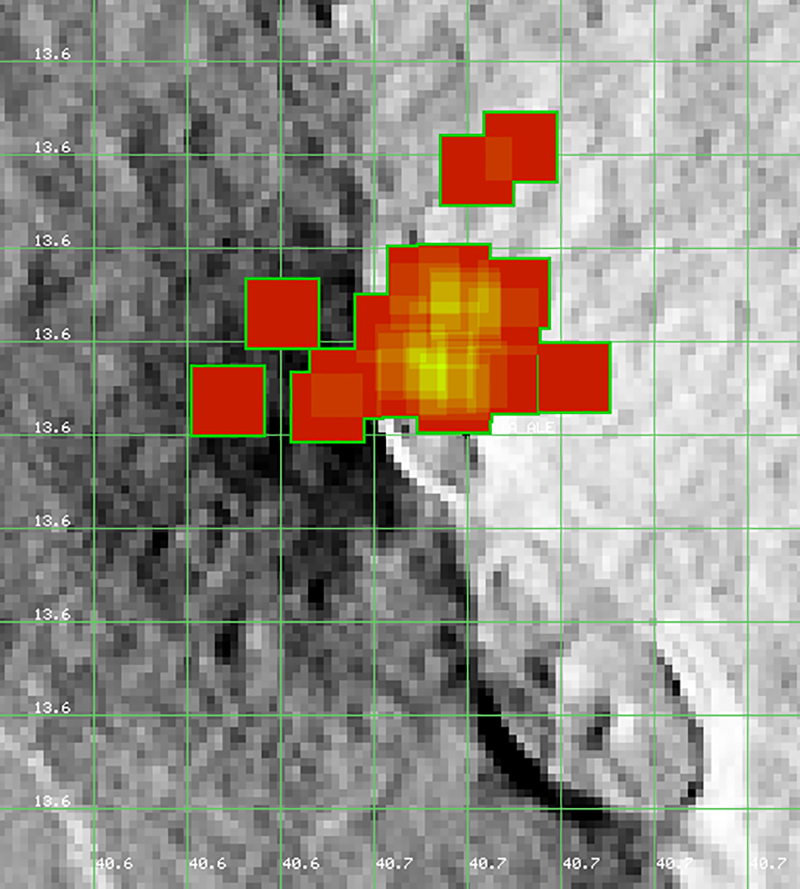Report on Erta Ale (Ethiopia) — October 2021
Bulletin of the Global Volcanism Network, vol. 46, no. 10 (October 2021)
Managing Editor: Edward Venzke.
Research and preparation by Paul Berger.
Erta Ale (Ethiopia) Episodes of strong thermal signals from lava lakes during March and May 2021
Please cite this report as:
Global Volcanism Program, 2021. Report on Erta Ale (Ethiopia) (Venzke, E., ed.). Bulletin of the Global Volcanism Network, 46:10. Smithsonian Institution. https://doi.org/10.5479/si.GVP.BGVN202110-221080
Erta Ale
Ethiopia
13.601°N, 40.666°E; summit elev. 585 m
All times are local (unless otherwise noted)
Erta Ale, Ethiopia’s most active volcano in one of the most desolate regions on Earth contains two active craters with lava lakes (North Pit and South Pit) in the summit caldera. Since February 2020, volcanism has been relatively low, except for a brief surge of thermal activity at the end of November 2020 (BGVN 45:05, 45:10, 46:02). This report summarizes activity during March-August 2021 and is based on satellite data.
During the reporting period, thermal anomalies based on MODIS satellite instruments analyzed using the MODVOLC algorithm, recorded frequent thermal alerts during 19-31 March, including ten days of hotspots with up to 4 pixels (figure 104). The March hotspots were the first since 30 November 2020. The MIROVA (Middle InfraRed Observation of Volcanic Activity) volcano hotspot detection system recorded a heavy concentration of strong thermal anomalies during the second half of March and a smaller pulse (less radiative power and fewer anomalies) of activity during the second half of May, with a few scattered hotspots during other months (figure 105).
 |
Figure 104. Location of thermal anomalies at Erta Ale in March 2021 detected by MODIS satellite instruments. Courtesy of HIGP MODVOLC Thermal Alerts System. |
Sentinel-2 infrared images also showed thermal anomalies suggestive of lava lakes present in both N and S crater pits during March through July 2021 (figure 106). A weak thermal signal can be seen on both 4 and 9 March from the S pit, which was much stronger on 19 March. Only five days later, on 24 March, a much strong thermal signal appeared in the N crater. Additional strong thermal anomalies at the N pit were detected on 29 March, 23 April, and 18 May. The S pit showed a strong thermal anomaly on 27 July. Small weaker anomalies were frequently present at one or both craters through August 2021.
Geological Summary. The Erta Ale basaltic shield volcano in Ethiopia has a 50-km-wide edifice that rises more than 600 m from below sea level in the Danakil depression. The volcano includes a 0.7 x 1.6 km summit crater hosting steep-sided pit craters. Another larger 1.8 x 3.1 km wide depression elongated parallel to the trend of the Erta Ale range is located SE of the summit and is bounded by curvilinear fault scarps on the SE side. Basaltic lava flows from these fissures have poured into the caldera and locally overflowed its rim. The summit caldera usually also holds at least one long-term lava lake that has been active since at least 1967, and possibly since 1906. Recent fissure eruptions have occurred on the N flank.
Information Contacts: MIROVA (Middle InfraRed Observation of Volcanic Activity), a collaborative project between the Universities of Turin and Florence (Italy) supported by the Centre for Volcanic Risk of the Italian Civil Protection Department (URL: http://www.mirovaweb.it/); Hawai'i Institute of Geophysics and Planetology (HIGP) - MODVOLC Thermal Alerts System, School of Ocean and Earth Science and Technology (SOEST), Univ. of Hawai'i, 2525 Correa Road, Honolulu, HI 96822, USA (URL: http://modis.higp.hawaii.edu/); Sentinel Hub Playground (URL: https://www.sentinel-hub.com/explore/sentinel-playground); NASA Worldview (URL: https://worldview.earthdata.nasa.gov/).



